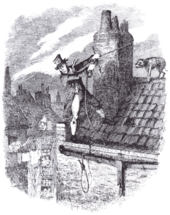George Cruikshank
George Cruikshank (born September 27, 1792 in London , † February 1, 1878 ibid) was a British cartoonist and illustrator . He is considered to be the successor to James Gillray, who died in 1815 .
life and work
George Cruikshank was born in London in 1792, the second son of the lithographer Isaac Cruikshank . At the age of twelve he began to illustrate tickets for children's lotteries, groschen books, greeting cards and street ballads. After Admiral Nelson's death in the Battle of Trafalgar in 1805, Cruikshank drew his funeral, a year later he caricatured Napoleon and the British King George III. In the following years a number of Napoleon caricatures emerged, but Cruikshank first gained notoriety in 1819 with the illustration of the satire The political house that Jack built by William Hone , which thematized the so-called " Peterloo massacre " of August 16, 1819. Cruikshank's breakthrough came with the illustration of Pierce Egan's Life in London , which was published monthly from October 1820 to 1821.
The illustrations by William Clarke Three Courses and a Dessert (1830) and William Carpenter's Political Alphabet (1831) cemented his reputation as the best English book illustrator. In addition to his political caricatures, Cruikshank illustrated, among others, Grimm's fairy tales (1823), Chamisso's Peter Schlemihl's miraculous story (1823), Defoe's Robinson Crusoe (1831), Don Quixote by Cervantes (1833), Scott's Waverley novels (1836) and the Oliver Twist by Dickens (1837).
Still under the impression of his father's alcoholic death in 1811, Cruikshank joined a temperance movement in 1847 that campaigned for a life free of alcohol. With the help of his illustrations, the two treatises The bottle and The drunkards children became a great success. Cruikshank made his last engraving in 1875 and died three years later in his hometown of London.
literature
- Ursula Bode, Marianne Müseler & Jürgen Schultze: George Cruikshank. 1792-1878. Caricatures on English and European politics and society in the first quarter of the 19th century. Hatje, Stuttgart 1983, ISBN 3-7757-0190-7 - catalog on the occasion of the first Cruikshank exhibition in Germany organized by the Wilhelm-Busch-Museum Hannover with mostly colored illustrations. The total of 176 caricatures included in the volume reflect the social and political situation in Great Britain and Europe between 1807 and 1826 and form a representative cross-section of the caricature oeuvre of Cruikshank.
- John Buchanan-Brown: The book illustrations of George Cruikshank. Newton Abbot [u. a.] 1980, ISBN 0-7153-7862-7
- Mary & Hilary Evans : The Man Who Drew the Drunkard's Daughter: The Life and Art of George Cruikshank, 1792–1878. Frederick Muller, 1978, ISBN 0584102593
- Mary Dorothy George: Hogarth to Cruikshank: social change in graphic satire. London 1967
- Albert Mayer Cohn: George Cruikshank: a catalog raisonné of the work executed during the years 1806-1877. With collations, notes, approximate values, facsimiles, and illustrations. London 1924
- Albert Mayer Cohn: A bibliographical catalog of the printed works illustrated by George Cruikshank. London [u. a.] 1914
- Robert L. Patten: George Cruikshank's life, times, and art. 2 volumes. London 1992 - Extensive reference work on the life and work of Cruikshank
- Christina Schenk: George Cruikshank's caricature in the change of the visual media. Lang, Frankfurt [a. a.] 1992, ISBN 3-631-43774-9
Web links
- The Political House that Jack Built - Hypertext Edition of the 44th Edition, 1820 (Kyle Grimes)
- SurLaLune Fairy Tale Pages: Fairy Tale Illustrations of George Cruikshank - Collection of fairy tale book illustrations (Heidi Anne Heiner)
- Works by the Cruikshank family in the British Museum
- Literature by and about George Cruikshank in the catalog of the German National Library
| personal data | |
|---|---|
| SURNAME | Cruikshank, George |
| BRIEF DESCRIPTION | British cartoonist and illustrator |
| DATE OF BIRTH | September 27, 1792 |
| PLACE OF BIRTH | London |
| DATE OF DEATH | February 1, 1878 |
| Place of death | London |


